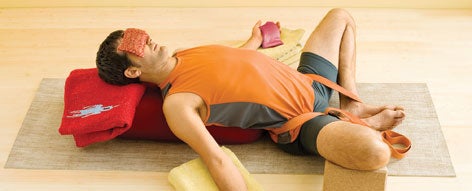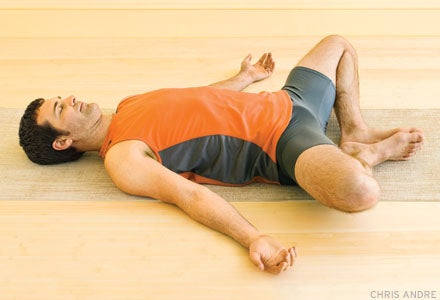Heading out the door? Read this article on the new Outside+ app available now on iOS devices for members! Download the app.

Ah, backbends. My one time arch enemy.
There was a time when we seriously didn’t get along. To be honest, I think I disliked them simply because I wasn’t good at them. They frustrated me. These gorgeous shapes looked like they should feel so good and yet when I attempted them I felt like I had just gotten back from a trip to the cement factory. I wanted my body to keep going but my spine wouldn’t budge. I’d look at the bendy spines around me and wonder how I missed out on the flexy-vertebra handouts.
So, I walked away defeated and kept working on everything else.
I eventually started practicing with Anusara teacher Noah Maze. This insanely talented (and flexible man) brought a new-found love to my backbend practice. He was so inspiring and diligent that I actually felt my heart opening up. I learned that you can’t “own” a backbend or “do” one—you surrender to it. These days, some of my favorite times on my mat are those where I set up my alignment and then fully let go into the pose and the moment. Don’t get me wrong—my backbends are certainly far from perfect. You’ll even see my poor little hips trying to lift in my final picture of Urdhva Dhanurasana (Upward-Facing Bow or Wheel Pose) above to no avail. But hey, the point is—I’m trying my best. Which is all I ask of you. Know your body, practice your alignment, and then give it your best shot. You’ll walk away stronger with a smile on your face (and in your heart). Have a a block and strap on hand for this practice.
Happy backbending.
Step 1:

It’s important to understand the work of the arms and shoulders before performing this large backbend, so go grab a block! Start in a seated with your bottom resting on your heels. Take your block the wide way in between your hands. Press your palms evenly into each edge like a sandwich. Extend your arms straight out in front of you. Extend the outer length of your arms as long as you can while pushing deeper into the pinky edge of your hand. Encourage the entire length of your arm to roll down and in to broaden your upper back. Relax the base of your neck as you lift your block up several inches. Keep the outer body long and the inner shoulders soft. Notice if your ribs are starting to puff out—draw them in and root your tailbone down toward the ground. Hold for several breaths then continue lifting the block up. Keep this pattern until you can’t go any higher without bending your elbows. You want to keep the arms straight, outer body extremely long and neck soft and happy. (I should mention this looks simple but your arms will be on fire by the time you’re done. Simple yet brutally effective work!)
Step 2:

Our elbows like to splay out during this transition so it’s best to train your arms using a strap. Make a lasso on your strap measuring it shoulder head to shoulder head (where the bone enters the socket). Place the strap around your arms just above the elbows. Lie on your mat with your knees bent and feet hip-width apart. Reverse your palms behind your shoulders, shoulder-width apart and fingertips facing your heels. The strap will knock you in the forehead—it’s annoying, but you’ll get used to it. (Small price to pay for safe shoulders.)
Step 3:

Press into both feet evenly and elevate your hips like you’re lifting toward Bridge Pose. Next, press into your palms and lift your chest and head up just enough so you can open your throat and place the crown of your head onto the ground. Have minimal weight resting on the ground with your head. Hug your elbows in over your wrists (the strap will aid you there) and keep your shoulder heads plugged into their sockets (don’t reach your shoulders toward your elbows). Think “toes in, heels out” to keep your feet parallel and begin a curling action of your chest—it will feel like you’re slowly rolling toward your hairline and the bottom tips of your shoulder blades toward your heart.
Step 4:

Time to pick this bad boy up! If this is newer to you, getting onto the crown of your head will be WORK. Don’t be ashamed to hold there and then rest. Trust me, this pose will open up to you when the time is right—not when you force it. So, if everything is still going well, press both of your palms firmly into the ground keeping all the principles of Step 3. Lift your head up off of the ground several inches, keeping your elbows bent and hugging in (think of loosening the strap). Press your shinbones back toward your calves and lift your hips up. Relax your neck completely as you spiral your upper inner thighs down to release your lower back (don’t squeeze your buns!).
Step 5:

If the last step felt good, it’s time to deepen the pose. Begin to straighten the arms without losing their rotation—outer arms back and in to broaden your upper back. Walk your feet in a few inches toward your hands as you bring your shoulders back so they get closer to stacking over your wrists (this will help relieve wrist pain in this pose). Come onto the balls of your feet to help lift the hips. Tilt your tailbone toward your knees to lengthen your lower back. Keep the hips this high, and without changing the height at all, slowly lower your heels, stretching through your Achilles back onto the ground. Relax your neck. Walk your feet back out, tuck your chin, and keep the elbows in as you bend and lower your body back onto the ground.
Kathryn Budig is jet-setting yoga teacher who teaches online at Yogaglo. She is the Contributing Yoga Expert for Women’s Health Magazine, Yogi-Foodie for MBG, creator of Gaiam’s Aim True Yoga DVD and is currently writing Rodale’s The Big Book of Yoga. Follow her on Twitter; Facebook; or on her website.
